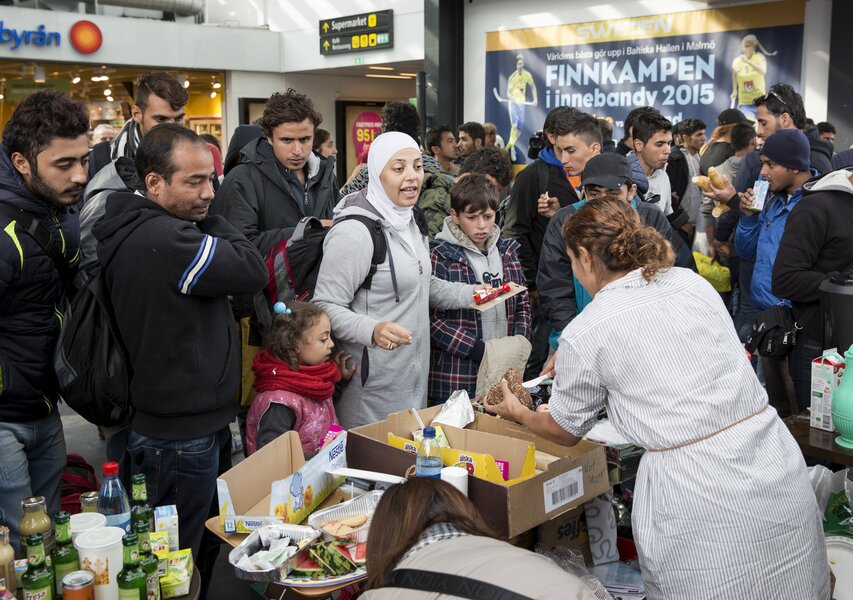Sweden welcomed refugees to seaside towns – until the weather got nice
Loading...
| Råå, Sweden
In spring and summer, there is no place more idyllic to spend a weekend than the Swedish beach town of Råå, with its cobblestone streets and charming little shops.
But as holiday-makers return for peak season this year, moving into rental cottages along the beach, they are displacing some unusual visitors: asylum seekers.
When last year’s refugee crisis brought an unprecedented refugee wave to Sweden, with some 10,000 asylum seekers arriving each week during October and November, the country’s Migration Agency quickly found its own residences filled. So it turned to the private market, renting virtually any decent housing offered to it: conference centers, hotels, former hospitals, camping sites.
For camping-site owners in particular, the asylum seekers were fantastic news, as they filled properties that would otherwise have stood virtually empty during the cold months. But as winter has turned to spring, camping sites and hotels are now canceling their contracts with the Migration Agency so they can house more profitable tourists.
To date, 42 camping sites housing nearly 2,000 asylum seekers have ended their contracts with the Migration Agency. As a result, asylum seekers are now having to leave their temporary homes to be housed in other Migration Agency-rented accommodation. Their fate raises the question of how asylum seekers in top destinations will fare in the long term.
"It's unbelievable how the Migration Agency treats asylum seekers," says Sally Karlsson, a resident in a tourist town near Råå where asylum seekers are also having to vacate camping cottages to make place for tourists. "We're talking about people who have settled and integrated well and whose children have built up relationships with teachers. Now they have make place for tourists and start over somewhere else. Treating people like this is incredibly inhumane."
Tourists pay twice as much for cottages
According to Kenneth Karlsson, the Migration Agency's national housing coordinator (and no relation to Sally), the agency never expected the asylum seekers to be able to remain in the holiday cottages for the duration of their asylum process. (Many asylum seekers who arrived last fall are still waiting for the Migration Agency's decision.)
"[The camping sites] were a resource during the autumn months of 2015," says Mr. Karlsson. During that time, the Migration Agency generally paid the maximum allowed rate of SEK 350 ($42) per person per day including food. Now the daily rate for one adult in a camping cottage is generally more than twice as much. And with the number of asylum seekers having plummeted since Sweden introduced passport controls at its border with Denmark, the Migration Agency now has more options.
"At the moment we have plenty of other housing opportunities available," says Mr. Karlsson. "When we move asylum seekers from ‘tourist sites,’ we try to use accommodation in nearby towns so the children can remain in their schools."
As for the camping site operators, they contend they have no moral obligation to keep the asylum seekers. “Only a tiny number of camping sites will keep them,” says Lars Isacson, CEO of the SCR, the association representing the majority of Swedish camping site operators. “Tourists are the camping site companies’ core business.”
Unsurprisingly, Mr. Isacson maintains that the companies haven’t taken advantage of the asylum seekers, but rather provided a needed service at a critical time. "They wanted to step up to the plate," he says. "It was a very tense situation when tens of thousands of asylum seekers had to be housed very quickly. Yes, the camping companies saw a business opportunity in renting to the Migration Agency. But operating camping sites is expensive. There’s a lot of wear and tear on the cottages during the cold months."
Warm welcome, but now what?
All the same, seeing the vacation cottages at Råå camping site now filled with Swedish tourists makes some feel sorry for the asylum seekers who endured the cold months next to the windy ocean only to leave as soon as the weather turned nice.
"Our government has chosen to welcome all these people fleeing from wars, Daesh [Islamic State], and destruction," reflects Ms. Karlsson. "But the government doesn't take responsibility for the people once they’re here."
Indeed, asylum seekers moved from beach cottages points to the big challenge now facing Sweden: how to integrate the asylum seekers it has valiantly received when other countries have given them the cold shoulder.





